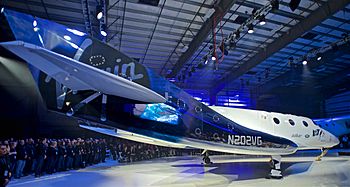Virgin Galactic Unity 21 facts for kids

VSS Unity in February 2016
|
|
| Mission type | Crewed suborbital spaceflight |
|---|---|
| Operator | Virgin Galactic |
| Apogee | 89.23 kilometres (55.44 miles) |
| Spacecraft properties | |
| Spacecraft | VSS Unity |
| Spacecraft type | SpaceShipTwo |
| Manufacturer | The Spaceship Company |
| Crew | |
| Members |
|
| Start of mission | |
| Launch date | 22 May 2021, 15:26 UTC |
| Launch site | Spaceport America Runway 34 |
| Deployed from | VMS Eve |
| End of mission | |
| Landing date | 22 May 2021 |
| Landing site | Spaceport America Runway 16 |
|
|
|
Virgin Galactic Unity 21 was an important test flight for future space tourism. It was a special kind of space trip called a sub-orbital spaceflight. This means the spacecraft went up into space and then came back down without going all the way around the Earth.
The flight happened on May 22, 2021. It used a spacecraft named VSS Unity, which is part of the SpaceShipTwo family. Two pilots, David Mackay and Frederick Sturckow, flew the mission.
This flight was a big deal because it was the first time humans flew into space from the state of New Mexico. It was launched from a special place called Spaceport America. The company behind this flight is Virgin Galactic, led by Richard Branson. They hope to take tourists to space one day!
During the flight, VSS Unity reached a height of about 89.23 kilometers (55.45 miles). In the United States, going higher than 50 miles (about 80.5 km) counts as reaching space. However, it did not cross the Kármán line, which is 100 kilometers (62 miles) high. This line is another way some groups define the start of space.
Meet the Crew
For this exciting flight, two experienced pilots were in charge:
- Pilot: David Mackay from the United Kingdom. This was his second spaceflight.
- Co-pilot: Frederick Sturckow from the United States. This was his sixth spaceflight.
These pilots helped test the spacecraft and make sure everything worked perfectly for future trips.
How the Flight Worked
The Unity 21 flight had a unique way of getting into the sky.
On May 22, 2021, VSS Unity did not launch from the ground like a rocket. Instead, it was carried high into the sky by its special mother ship, named VMS Eve. Think of it like a smaller plane attached underneath a much bigger plane. This is called a parasite configuration.
At 3:26 PM UTC, when they were high enough, VMS Eve released VSS Unity. This is known as a drop launch. Once released, the pilots, MacKay and Sturckow, fired Unity's rocket engine. The spacecraft quickly sped up to a maximum speed of Mach 3. Mach 3 means it was flying three times faster than the speed of sound!
VSS Unity then climbed to its highest point, over 89.23 kilometers (55.45 miles) above Earth. After reaching this altitude, the spacecraft began its glide back down. Both VSS Unity and its mother ship, VMS Eve, landed safely back at Spaceport America. This successful test was a big step for Virgin Galactic's plans for space tourism.

